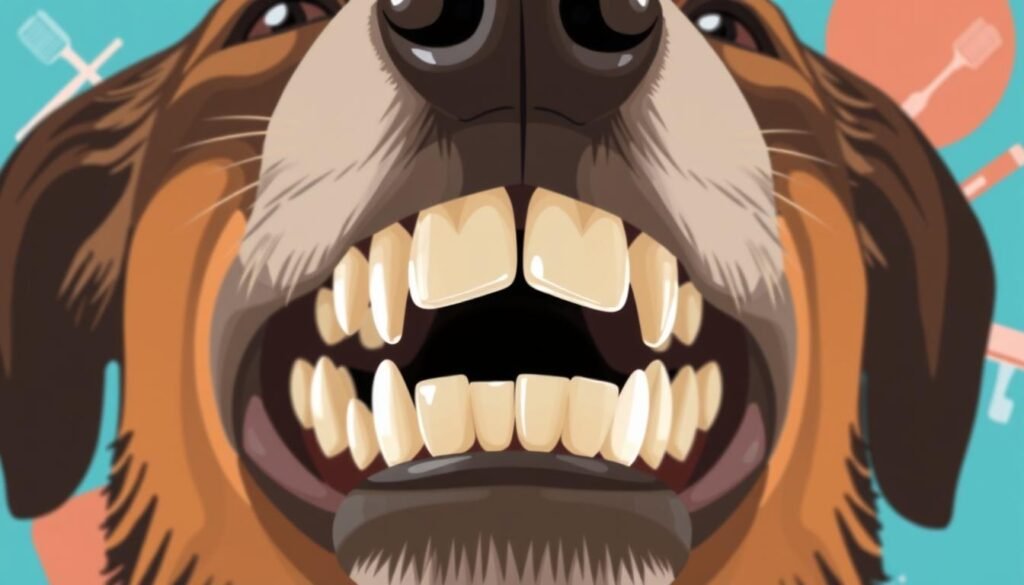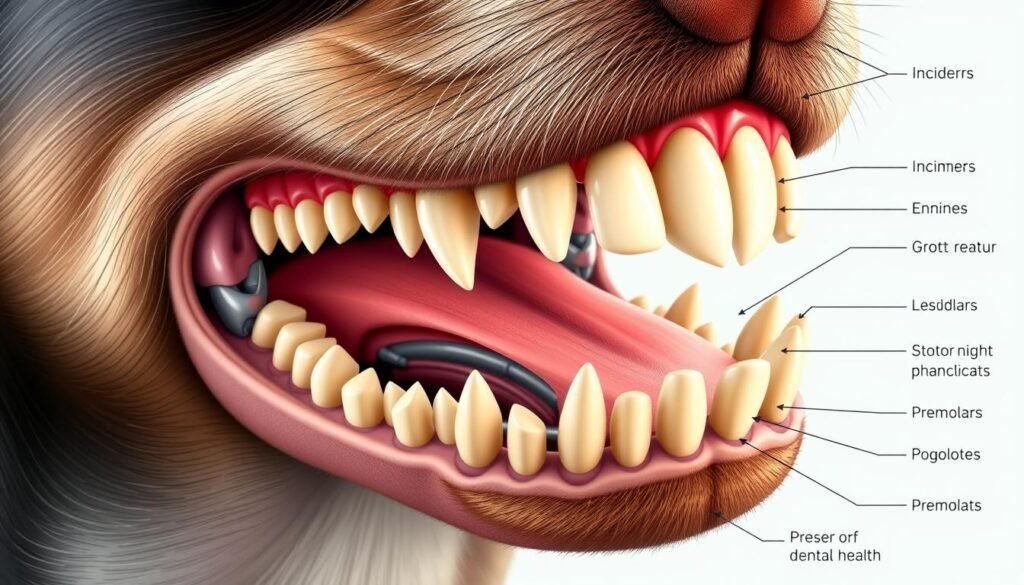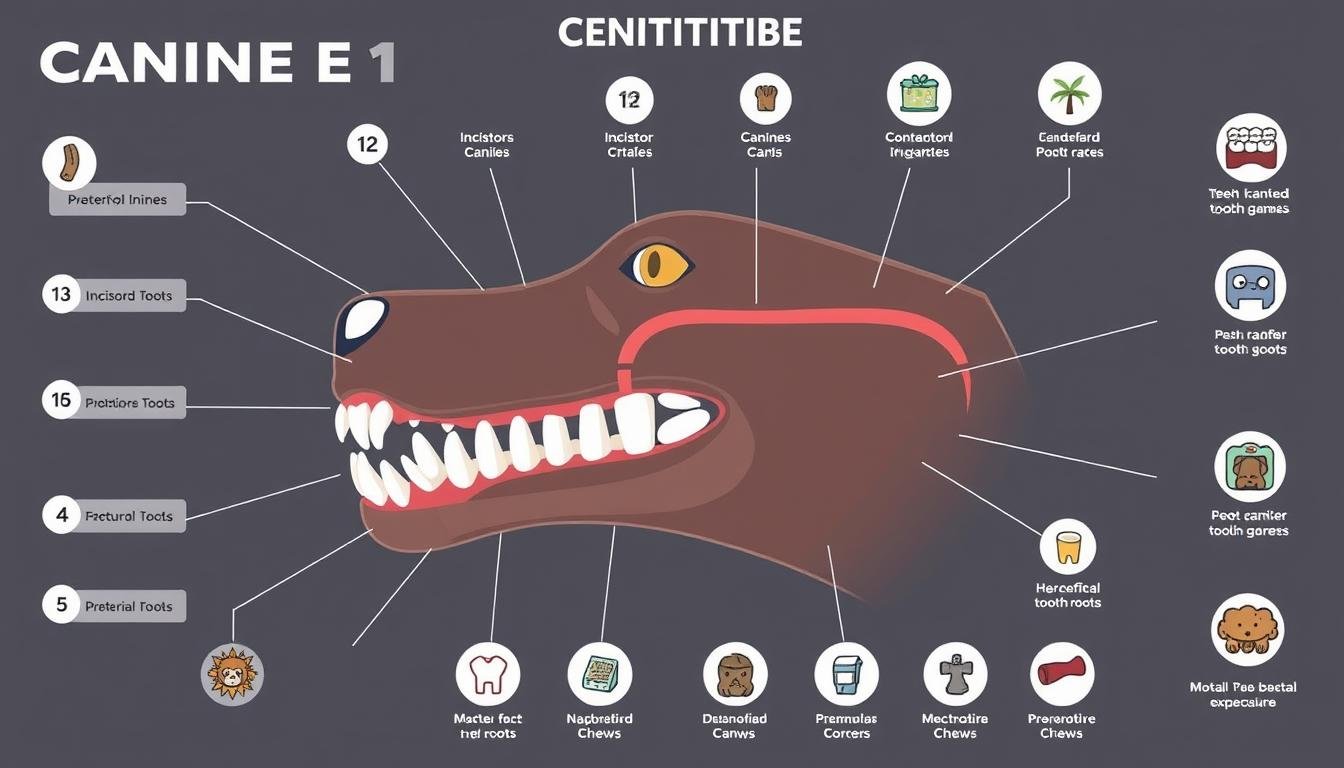As pet owners, we often overlook our canine companions’ oral health. But, keeping their mouths healthy is key to their overall well-being. This guide will explore the canine dental chart, highlighting the need for regular dental care and the risks of neglecting it.
Key Takeaways
- The canine dental chart provides a detailed roadmap of your dog’s oral health.
- Proper dental care, including regular checkups and cleanings, is essential for preventing dental problems in dogs.
- Neglecting your dog’s dental health can lead to serious conditions like periodontal disease, tooth loss, and even systemic infections.
- Understanding the canine dental chart can help you and your veterinarian monitor your dog’s dental health and take proactive steps to maintain it.
- Incorporating at-home dental care, such as tooth brushing, can significantly improve your dog’s oral hygiene and overall health.
The Importance of Canine Dental Health
Keeping your dog’s teeth clean is key to their health. Regular vet visits and good dog dental health habits can stop big problems. These include gum disease, tooth loss, and infections that harm vital organs.
Why Regular Dental Care Matters for Dogs
Dogs need regular dental care just like humans. If they don’t get it, they face many issues. These include:
- Plaque and tartar buildup, causing gum inflammation and periodontal disease
- Tooth decay and tooth loss, leading to pain and eating troubles
- Bacterial infections that can spread to the bloodstream and vital organs
- Foul breath, a sign of dental problems
Consequences of Poor Dental Hygiene in Dogs
Ignoring can dogs eat shrimp and dental care can harm your dog. Untreated dental issues can cause:
- Chronic pain and discomfort, making eating hard
- Higher risk of systemic infections harming the heart, liver, and kidneys
- Potential tooth loss, affecting chewing and diet balance
- Behavioral changes, like aggression or mouth reluctance
By focusing on dental care for dogs, you keep them healthy and happy. This ensures they live a long, joyful life.

Anatomy of a Dog’s Mouth
To take care of a dog’s teeth, it’s key to know their mouth’s anatomy. Dogs have different teeth, each with its own job in their dental health.
Types of Teeth and Their Functions
Dogs have four main types of teeth, each important for their dental health:
- Incisors: These small, sharp teeth at the front of the mouth are used for biting and cutting food.
- Canines: The long, pointed teeth on the sides of the mouth are for tearing and grasping.
- Premolars: These teeth, behind the canines, help chew and grind food.
- Molars: The large, flat teeth at the back of the mouth also help with chewing and grinding.
Understanding the dog teeth structure and canine dental anatomy helps pet owners spot issues early. This way, they can give the right care to their pets.

“Knowing the structure and purpose of a dog’s teeth can help pet owners recognize potential problems and provide appropriate care.”
Decoding the Canine Dental Chart
Learning about a canine dental chart is key for your dog’s teeth health. It’s like a map for vets and pet owners. It helps track your dog’s dental health and spot problems early.
A dog dental chart breaks down into four parts, one for each mouth section. Each tooth has its own number and label. This makes it easy to keep track of each tooth’s health.
- The counting starts at the front, with the top left as #1 and the bottom left as #4.
- Every tooth gets a special number. This makes it easy to talk about tooth health with vets.
- The chart uses symbols for dental problems like missing teeth or disease signs.
“Regularly reviewing your dog’s dental chart with your veterinarian can help you stay ahead of any potential oral health issues and ensure your furry friend maintains a healthy, comfortable smile.”
Knowing about the canine dental chart lets you help with your dog’s dental care. You can work better with your vet. This way, your dog can have a healthy smile all their life.
Common Dental Problems in Dogs
Keeping our dogs’ teeth clean is key to their health. But, they can still face dental issues like plaque, tartar, tooth decay, and gum disease. Knowing about these problems helps keep our furry friends healthy.
Signs and Symptoms to Watch Out For
Watch for signs of dog dental problems. Look for bad breath, trouble chewing, swollen gums, and loose teeth. Also, check for excessive drooling, facial swelling, or pain.
If you see these signs of dental issues in dogs, get your pet checked by a vet fast. Early treatment can stop bigger problems and keep your dog’s teeth healthy for years.
| Dental Problem | Description | Symptoms |
|---|---|---|
| Plaque and Tartar Buildup | Accumulation of bacteria and minerals on the teeth | Bad breath, discolored teeth, gum inflammation |
| Tooth Decay | Erosion of the tooth enamel, leading to cavities | Sensitivity, pain when chewing, discoloration |
| Gum Disease (Periodontal Disease) | Inflammation and infection of the gums and supporting structures | Bleeding gums, bad breath, tooth loss |
| Oral Infections | Bacterial or viral infections in the mouth | Swelling, pain, difficulty eating |
Knowing about dog dental problems and their signs of dental issues in dogs helps. It lets us take care of our dogs’ teeth and prevent serious issues later.
Canine Dental Chart: A Comprehensive Guide
Learning about a canine dental chart’s numbering system is key for your dog’s oral health. This guide will help you understand this important veterinary tool. It will also help you work better with your pet’s healthcare team.
Understanding the Numbering System
The canine dental chart uses a standard numbering system to track each tooth in a dog’s mouth. This system goes from 1 to 32, showing the total number of permanent teeth in a grown dog. The numbers are set up to show the different types of teeth and where they are in the mouth.
- The numbers 1 through 4 show the incisors, at the front of the mouth.
- Numbers 5 and 6 are the canine teeth, or “fangs,” next to the incisors.
- Teeth 7 through 10 are the premolars, behind the canines.
- The molars, the biggest and back teeth, are numbered 11 through 14.
This method makes it easy for pet owners and vets to talk about dental issues. It helps them understand and solve any problems.
“Understanding the canine dental chart numbering system is essential for maintaining your dog’s dental health. It allows you to work closely with your veterinarian to identify and address any problems that may arise.”
By learning about the canine dental chart and its dog dental chart numbering system, you can help your dog’s health. You’ll be able to spot problems early, talk well with your vet, and make sure your dog gets the dental care they need.
Preventive Measures for Optimal Dental Health
Keeping your dog’s teeth clean is key to their health. Taking steps early can stop big dental problems. This way, your dog can live a happy, healthy life. Let’s look at the best ways to keep your dog’s teeth in top shape.
Regular Veterinary Check-ups
Regular vet visits are the first step in dental care for dogs. Your vet will check your dog’s teeth and gums for any problems. They can clean, scale, and polish your dog’s teeth to keep them clean.
Professional Dental Cleanings
Professional dental cleanings are also crucial for dog dental care. These deep cleanings remove plaque and tartar and fix dental issues. Getting these cleanings regularly is important for preventive dental care for dogs.
At-Home Dental Routines
At-home care is also important. Brushing your dog’s teeth with dog-safe toothpaste is a must. Dental chews and toys can also help keep teeth clean between vet visits.
| Preventive Measure | Frequency | Benefits |
|---|---|---|
| Veterinary Check-ups | At least annually | Early detection and treatment of dental issues |
| Professional Cleanings | Typically every 6-12 months | Removal of plaque and tartar, maintaining oral health |
| At-Home Dental Routines | Daily or several times per week | Reduction of plaque buildup, fresher breath, and healthier teeth |
By using a mix of vet visits, professional cleanings, and at-home care, you can keep your dog’s teeth healthy. This ensures your dog has a better life.
At-Home Dental Care for Dogs
Keeping your dog’s teeth clean is key. Luckily, there are many ways to do this at home. You can brush their teeth and use other methods to keep their smile shining.
Tips and Tricks for Brushing Your Dog’s Teeth
Brushing your dog’s teeth is a big part of their dental care. Here are some tips to help:
- Start early: Get your dog used to tooth brushing when they’re young. It makes it easier for them.
- Choose the right tools: Pick a soft-bristled toothbrush and toothpaste made for dogs. It’s safer and more comfortable for them.
- Go slow and be patient: Begin with a few teeth and slowly add more. This helps your dog get used to it.
- Make it a positive experience: Use treats and praise to make tooth brushing a good thing for your dog.
- Establish a routine: Brush your dog’s teeth at the same time every day. This makes it a regular part of their routine.
By following these tips, brushing your dog’s teeth can be easy and effective.
Other At-Home Dental Hygiene Practices
There are more ways to help your dog’s dental health at home:
- Provide dental chews and treats: Choose products that clean teeth and freshen breath.
- Use water additives: Add dental solutions to their water to fight plaque and tartar.
- Schedule regular veterinary check-ups: Professional cleanings and checks help catch dental problems early.
Using these at-home dental care practices can help keep your dog’s teeth and smile healthy.
Professional Dental Care for Dogs
Keeping your dog’s teeth clean at home is important. But, regular vet visits for dental care are just as key. These vet visits offer a deeper clean that you can’t do at home.
At these visits, your vet will check your dog’s mouth and clean it thoroughly. They might also polish teeth, apply sealants, or fix any dental problems.
The Importance of Regular Vet Dental Cleanings
Regular professional dog dental care has many benefits:
- It removes plaque and tartar that brushing can’t get.
- It helps prevent gum disease and tooth decay.
- It lets the vet catch dental problems early.
- It keeps your dog’s mouth healthy, which is good for their overall health.
The vet dental cleaning for dogs is done while your dog is under anesthesia. This makes sure they’re comfortable and safe. Your vet will tell you how often your dog needs these cleanings.
| Procedure | Description | Average Cost |
|---|---|---|
| Professional Dog Dental Cleaning | Thorough cleaning, scaling, and polishing of teeth | $300 – $700 |
| Dental Extractions | Removal of damaged or diseased teeth | $150 – $450 per tooth |
| Dental X-Rays | Diagnostic imaging to assess dental health | $75 – $200 |
Investing in professional dog dental care is vital for your dog’s health. Working with your vet ensures your dog has a happy, healthy smile for life.
FAQ
A canine dental chart is a visual tool for tracking a dog’s teeth health. It helps vets and pet owners spot dental issues early. It shows a dog’s teeth types, where they are, and their condition.
Good dental care is key for a dog’s health. It stops serious problems like gum disease and tooth loss. It also prevents infections that can harm vital organs.
Dogs have many teeth, each with a special job. They have incisors, canines, premolars, and molars. Knowing this helps pet owners spot and fix dental issues.
A canine dental chart helps track dental health. It uses a numbering system. Understanding it helps you work with your vet to keep your dog’s teeth clean.
Dogs face many dental issues, from plaque to gum disease. Knowing the signs helps you get vet care fast.
Conclusion
Understanding the canine dental chart and proper dental care is key for your dog’s health. By following the guidelines in this article, you can help your dog have a lifetime of canine dental health and dog teeth health.
Keep an eye on your dog’s teeth, care for them at home, and see a vet when needed. These steps are vital for your pet’s oral health. By focusing on dental health, you can avoid pain, improve your dog’s life, and strengthen your bond.
A healthy smile is the base of your dog’s well-being. Use the knowledge and resources from this guide. Start a journey to keep your dog’s teeth healthy and strong for many years.










